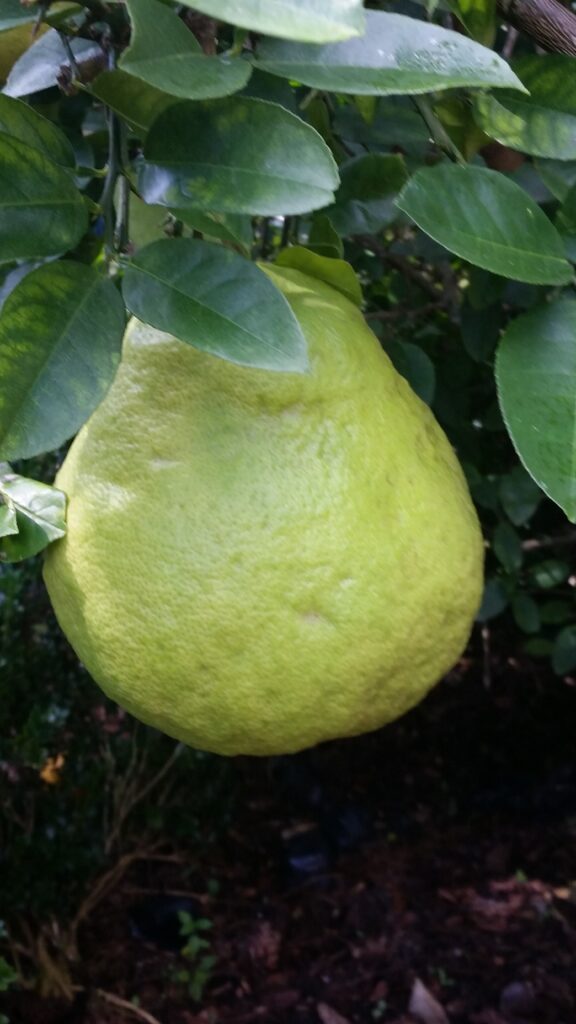Growing Ponderosa Lemons
in Northeast Florida Landscapes
( Citrus x limon Ponderosa )
Origin of Ponderosa Lemons For Northeast Florida :

Ponderosa lemons are an oddity, grown more for their unique large fruits than for their garden stability. Ponderosa lemons are less cold hardy than other Lemon selections, although still more cold tolerant than lime trees.
They make up for that cold sensitivity by rewarding their winter protector with fruit year round, rather than just in the fall and summer. Fruits are large, football sized lemons. ( My boys are always throwing them around in the yard) The juice of a single wedge of a Ponderosa is equal to the juice of an entire grocery store lemons juice…can you imagine just a tiny piece of it gets you the same amount of juice as an entire lemon!
Another unique feature of the Ponderosa lemon is the large waxy flowers that are many times larger than a traditional citrus blossom. In addition, Ponderosa lemons have the ability to be in bloom and bearing fruit at the same time, making them a unique ornamental specimen plant that any gardener would love.
Ponderosa lemons, like Meyer lemons, are not classified a true lemon, they are a result of a hybrid cross. Although parentage is still debatable, it is widely accepted that Ponderosa lemons are a cross between ‘Citrus and Citron’. And the fruit have much the appearance and size of a citron and all the flavor of a lemon.
 Winter Temperature Tolerance For Ponderosa Lemon Trees:
Winter Temperature Tolerance For Ponderosa Lemon Trees:
Lemons are the most cold sensitive of Citrus fruit and should only be planted in zones 9-11. Ponderosa Lemons are the most sensitive to winter temperatures of all of the lemon selections. Extreme caution should be taken to protect trees from temperatures below 20 degrees.
See Lemon Home for details on where to plant lemon trees in Northeast Florida gardens.
Sun Exposure for the Ponderosa Lemon Tree in Northeast Florida:
Plant Ponderosa Lemon trees where they will receive full sun in the Jacksonville and St. Augustine area landscapes.
Foliage of the Ponderosa Lemon Tree:
Ponderosa lemon trees have long, evergreen dark glossy lemon scented leaves. To me, it`s similar to a grapefruit tree with large leaves and large fruits!
Soil Preference for the Ponderosa Lemon Tree:
It is no longer a recommended practice to amend the soil in the planting hole on Citrus trees in good soil according to the University of Florida’s Institute of Food and Agricultural Sciences.
However, probably due to the simple fact that old habits die hard, one UFIFAS citrus publication cautions, if you are going to amend your soil be sure to use a 50-50 ratio. In other words, use equal parts soil amendment and native soil (that is the soil you dug out of the hole before placing the tree in it), and mix the amended soil together with the native soil before backfilling the hole around the tree.
Planting and Mulching Tips For Ponderosa Lemon Trees in the Jacksonville or St. Augustine area landscape:
NOTE: THIS IS IMPORTANT, I am going to say this three times in three different ways and hope at least one of these makes some sense!
– Be sure to plant into well draining soils, and keep the soil level of the dirt in the container above the soil level of the ground by 1-2 inches when you are finished planting.
– The soil that your tree was growing in should be slightly higher or level with the ground. Never plant the tree where the root ball of the tree once planted into the ground is lower than the grade of the yard.
– Never bury the top of the root system that the tree was growing in. The soil in the top of the pot should be exposed to the air after planting, not buried by soil in any way.
Caution: Do not build berms around Citrus to hold water, as is recommended for pretty much all other trees. Leave a 12 inch diameter area around Citrus tree trunks with no mulch, do not put mulch up to the trunk of the tree on Citrus Root rot can develop quickly and good drainage is essential to a healthy tree.
Remove the grass and weeds growing under the foliage of any Citrus tree in Northeast Florida about a foot beyond where the foliage stops. Don’t allow grass and weeds to regrow under your Florida Citrus.
When planting in areas with a high water table, consider planting your Citrus into a raised berm a few feet high and 6 or more ft wide. This will keep your Citrus roots up out of the water soaked ground during periods of heavy rain.
Wow, that was allot of don’ts! Here’s one last one. Don’t worry, it really isn’t as hard as it seems, once you get them going Citrus trees just keep on growing!
Size of the Ponderosa Lemon Tree When Mature:
The mature size on a Ponderosa lemon tree is around 12-20+ ft tall and 10-15ft wide depending on pruning practices.
Pruning and Growth Habits of Meyer Lemon Trees for the Northeast Florida Landscape:
Ponderosa trees should be pruned to develop an open rounded canopy with a mushroom shape.
Pruning may be needed on occasion to remove suckers that sprout up from the trunk, or to remove dead wood that can cause problems when left on the tree.
When purchasing trees from an S & J Nursery container less than a 30 gallon pot size, pruning may be needed to shape the young trees into a desirable framework, and light pruning each year to develop the lemon trees rounded or mushroom shaped canopy.
As the tree matures it should be shaped by selecting 3-5 main branches, well spaced along the trunk for fruiting production. Remove branches with narrow angles, and sub branches that are crossing or rubbing on other branches.
Pruning Tip for Citrus Trees: Light but frequent ( meaning once or twice a year, not monthly) pruning has a tendency to relocate fruit from being produced mainly on branch tips to inside the canopy of the citrus tree. This can help increase the trees yield and keep the end heavy branches from breaking during overly productive years on some Citrus species.
Blooms and Fruit of Ponderosa Lemon Trees for Northeast Florida Landscape:
There may be nothing quite like a citrus tree in full bloom. The smell is magnificent! Mature citrus trees are said to be able to produce up to 100,000 blooms in a single year! They bloom mostly in early spring in Florida, but often do a smaller summer flowering around June that will produce a smaller second crop of fruits giving the selection the name “ever-bearing”.
Ponderosa lemons have flowers on them on and off throughout the year although most notably in early spring. Flowers and fruit are equally large in comparison with other lemon cultivars. Fruit has a good lemon flavor, but is quite seedy.
Ponderosa lemon trees are self pollinating, so there is no need for a second tree to pollinate your lemon tree in order for it to produce fruit.
Water Requirements of the Ponderosa Lemon in Northeast Florida:
Newly planted citrus trees require watering every other day for the first month and twice a week for the first few months, or in sandy soils when the top two inches of soil is dry to the touch. Take care to make sure that newly planted citrus trees receive water at least once a week for the first 2 years after being planted, skipping watering altogether once the local rain season is here.
Mature citrus trees need little to no supplemental irrigation and are more often damaged by over watering than under watering.
When citrus trees do need supplemental irrigation during times of drought or as young trees, make sure to irrigate the soil only and not the trunk or foliage, this is best done by hand with a hose.
Keeping your Ponderosa Lemon Tree Free from Pests and Diseases:
When it comes to gardening, an ounce of prevention is worth a pound of cure. That is to say that, paying attention to proper planting, watering and fertilizing practices for your tree is the best way to keep it healthy and growing well.
Lemon trees tend to be a bit demanding on the fertilizing side of the equation. Ponderosa lemon trees are in constant fruit production and spreading out the fertilizer applications to every 6 weeks from January to September. Remembering that here in Northeast Florida we don’t want to fertilize citrus in the fall months making it more succeptable to frosts, so September is the last planting date you can safely. will benefit fruit production. A good quality fertilizer specifically formulated for citrus trees should be used. Fertilize in spring, again in summer and ,skip the fall application in Northeast Florida, and then again in January. Spread your fertilizer out into the circle of non grass area under the Canopy of your citrus tree.
Harvesting your Fresh Ponderosa Lemon Tree’s Fruits:
A Single Ponderosa lemon tree when mature will produce more fruit than one family can use. The large yellow fruit will ripen year round on the tree and can be harvested anytime.
Other Great Citrus Trees available at S & J Nursery
for the Northeast Florida,
Jacksonville | St. Augustine Area Gardens
Bearss Lemon

